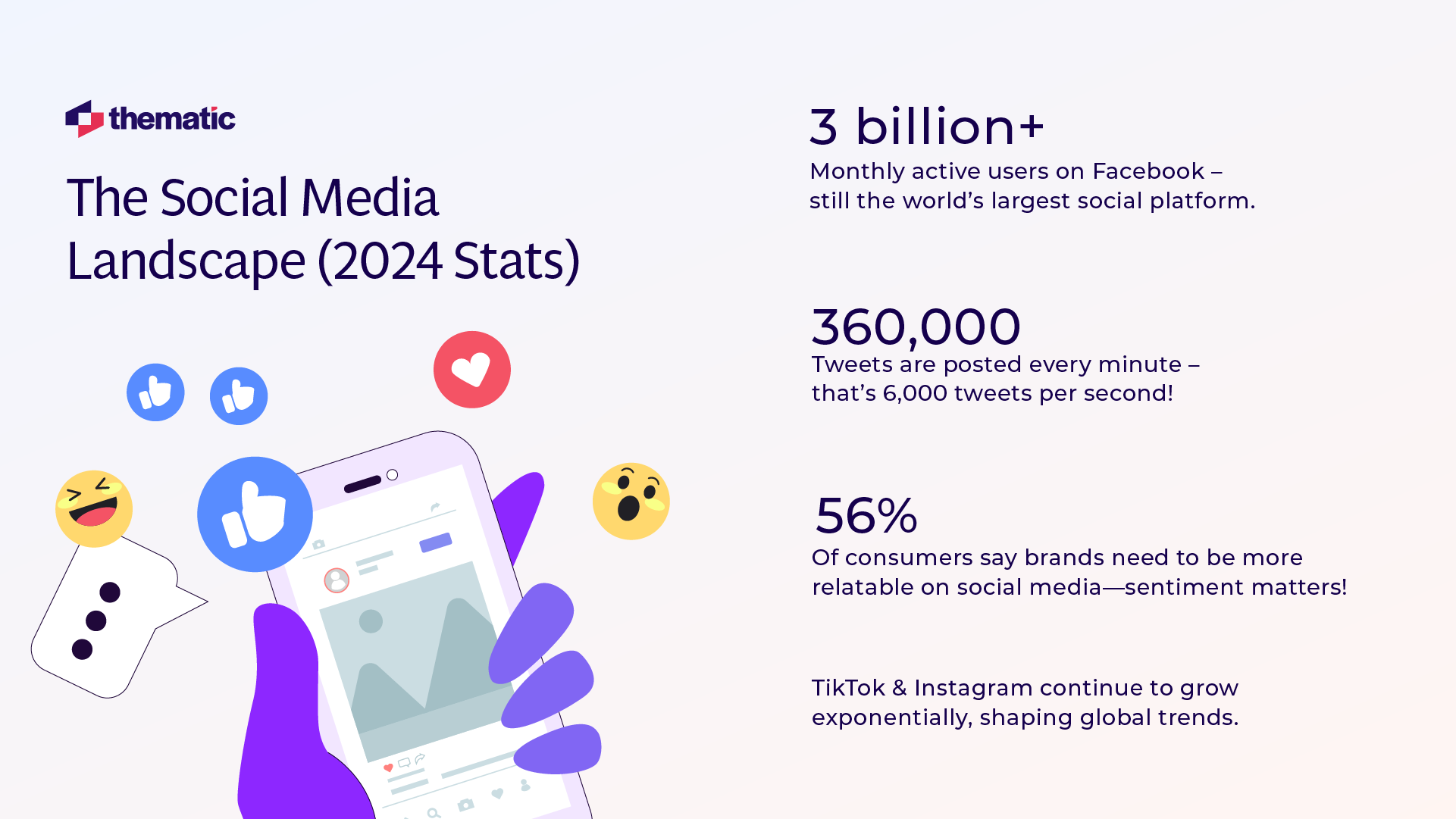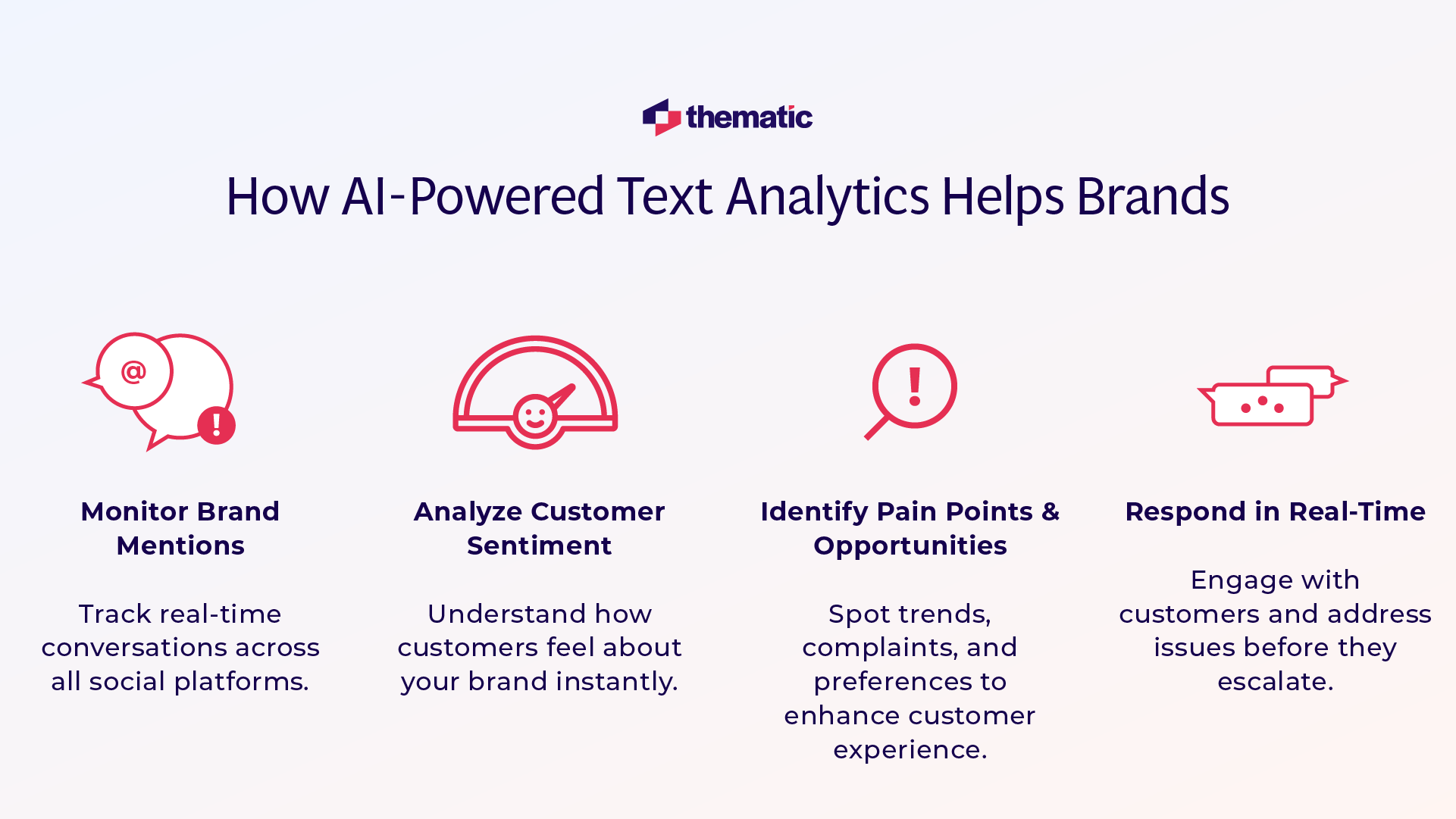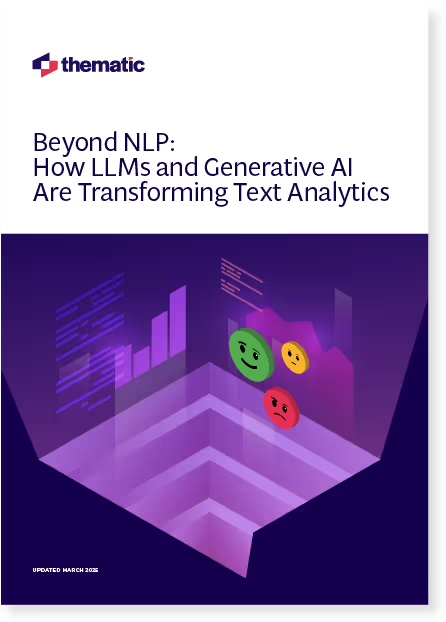
Learn how text analytics for social media helps monitor trends, analyze sentiment, and enhance customer engagement.

Is your business on social media? Then you’ve probably seen how one viral tweet, a trending hashtag, or a wave of customer complaints can shift public perception overnight. In this digital age, brands need more than just social listening—they need real-time insights to stay ahead of the conversation.
But here’s the challenge: millions of posts, comments, and reviews flood social media daily. It’ll take up so much time if you jump in and read all of them, don’t you think?
It’s a good thing there’s text analytics for social media. With AI-powered tools, businesses can decode unstructured text, measure sentiment, and spot patterns across platforms in seconds! From improving customer engagement to mitigating PR crises, text analytics helps companies make data-driven decisions instantly.
Let’s talk more about AI-powered text analytics and how you can use it on your social media.
If you’re on social media, you’ve seen an endless stream of conversations—brand mentions, customer feedback, trending discussions, and viral content. With over 3 billion monthly active users on Facebook and platforms like TikTok and Instagram growing exponentially, brands need a way to filter, analyze, and act on this data in real time. They need text analytics for social media.
It’s an AI-powered technology that processes unstructured text data, transforming it into meaningful insights. While the history of text analytics dates back to early computational linguistics and keyword tracking, advancements in AI have revolutionized the field, making it more sophisticated and accurate than ever.
Today, in just seconds, you can scan thousands of social media posts, reviews, and comments to extract sentiment, detect trends, and identify customer pain points. No need to manually sift through content; you can automate analysis and focus on strategic action.
How Text Analytics Helps Businesses Stay Ahead
1. Monitoring Brand Mentions Across Platforms
2. Tracking Customer Sentiment & Industry Trends
Identifying Customer Pain Points & Opportunities
A data-driven approach enhances customer engagement, boosts brand loyalty, and improves sales conversions.
According to a study by Bruce et al. in 2025, "Both Social Media Analysis (SMA) and analyses of publicly available online data can contribute to a better understanding of societal phenomena and changes in public opinion over time, providing direct access to community opinion beyond traditional evaluation methods."

Ever wondered what customers really think about your brand? No, not just what they say in surveys, but their raw, unfiltered emotions—the kind they express in tweets, Facebook rants, or glowing Instagram reviews?
If you want to know, then you need sentiment analysis.
If text analytics is the broader process of extracting meaningful insights from unstructured text data, sentiment analysis is one of its most powerful techniques.
Sentiment analysis often uses AI approaches to automate the detection of emotions in text, categorizing them as positive, neutral, or negative. If you apply this method to social media conversations, you can understand customer emotions at scale, and with that, you can react to trends, improve experiences, and prevent PR disasters.
That’s exactly how Instacart used sentiment analysis to improve its customer experience. The grocery delivery giant analyzed customer reviews from the Apple App Store and Google Play Store, identifying key pain points. By tracking sentiment in user-generated feedback, Instacart was able to:
The AI-powered sentiment analysis helped Instacart ensure that it’s always listening to its customers, adapting its services based on feedback, and staying ahead in a highly competitive market.
Real-time analysis is no longer optional—it’s a necessity. Customers expect brands to be responsive, and delayed reactions to negative feedback can escalate into full-blown PR crises. That means being able to analyze sentiment instantly and engage proactively gives your brands a competitive edge–better customer experiences and stronger brand loyalty.
Here’s how it works:
✅ Immediate response to customer complaints = better CX
A fast resolution can turn an unhappy customer into a brand advocate.
✅ Competitive advantage in trend detection
Brands that spot sentiment shifts early can adjust their marketing, product offerings, or messaging before issues escalate.
Starbucks understood this. It uses real-time sentiment analysis to track customer reactions on X, blogs, and online forums. During product launches, AI-driven monitoring helps detect instant feedback on new drinks and promotions.
If complaints arise—like dissatisfaction with a new coffee blend—Starbucks quickly pivots:
So, don’t just let your social media conversations go unchecked. Use conversational analytics and real-time sentiment analysis to track expectations, respond proactively, and enhance customer experiences.

Yes, social media is indeed a goldmine of customer insights—but only if you know how to extract them. Customer review analysis and easy feat because millions of posts, tweets, and comments are shared every day. You need a way to cut through the noise to identify what really matters. But don’t worry, there’s such a thing as topic modeling.
Topic modeling helps automatically group similar discussions, making qualitative data analysis easy. With this tool, you uncover the most talked-about themes in customer conversations. So, rather than you alone sorting through thousands of comments, you have AI to do the heavy lifting—identifying key topics and organizing them into meaningful patterns–and you just build strategies.
Understand trending topics related to products & services
Guide Marketing & Product Development Decisions
Just think of this: A beauty brand might find that social media users are raving about a new skincare ingredient. Using topic modeling, they can track how this trend evolves, adjust marketing strategies, and even launch new product lines based on consumer interest. No longer is customer satisfaction hard to reach.
Thematic can do this for you and more!
Is your Text Analytics solution still relying on B-Grade NLP? Discover how large language models are revolutionizing text analytics, offering deeper insights than traditional NLP approaches.

Social media generates vast amounts of unstructured text data every second. Can you still keep up with the comments on your social media page? Can you still make sense of them? Advanced AI solutions that go beyond simple keyword tracking is what you need, particularly, large language models (LLMs).
In the past, natural language processing (NLP) was the go-to method for analyzing text. While NLP helped with sentiment detection and topic extraction, it had limitations—it struggled with context, nuance, and evolving language patterns.
Now, solutions like Thematic have moved beyond NLP, leveraging LLMs for greater accuracy and scalability. LLMs can:
With AI-driven thematic analysis software, you can turn social media noise into actionable insights, ensuring smarter, data-driven decisions.

Social media is where brand reputation is built—or broken. Text analytics for social media empowers businesses to track sentiment, detect trends, and respond to customer feedback in real time. From sentiment analysis to AI-driven topic modeling, brands can turn unstructured conversations into actionable insights that improve customer experience and drive smarter decisions.
With real-time monitoring, businesses can catch PR crises before they escalate, optimize marketing strategies, and refine product offerings based on what customers truly want. The best text analytics software solutions, like Thematic’s advanced text analytics platform, take this a step further, leveraging LLMs for deeper, more accurate insights.
Why rely on guesswork when you can see exactly what your customers think? Experience the power of AI-driven text analytics and unlock real-time insights.
Join the newsletter to receive the latest updates in your inbox.